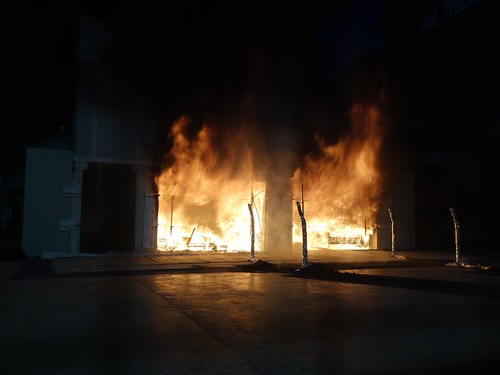
Wood buildings provide an array of economic and environmental benefits to their communities, and interest in capitalizing on those benefits by constructing mid to high-rise buildings using cross-laminated timber (CLT) is growing.
CLT is made from layers of dried lumber boards stacked in alternating direction at 90-degree angles, which are then glued and pressed to form solid panels. These panels have exceptional strength and stability and can be used as walls, roofs, and floors. Additionally, evaluations have shown that a seven-inch floor made of CLT has a fire resistance of two hours.

In order for wood structures to rise above six stories without special building official permission, the International Building Code must be revised. That might sound like a tall order, but researchers from the Forest Service’s Forest Products Laboratory (FPL) recently completed a series of fire tests that will address concerns about the fire performance of wood buildings and help take them to new heights.
In cooperation with the American Wood Council, the Bureau of Alcohol, Tobacco, Firearms, and Explosives (ATF), and the Forest Service’s State and Private Forestry, FPL researchers recently recreated five fire scenarios in a two-story, full-scale test building constructed using CLT. The results were promising.
“These tests demonstrate that it is possible to build a CLT building that’s fire resistant, even with exposed CLT,” said Sam Zelinka, project leader for the Building and Fire Sciences unit at FPL.

The test building, constructed at the ATF’s Fire Research Laboratory in Beltsville, Maryland, consisted of two identical, furnished one-bedroom apartments. The scenarios tested various arrangements of exposed and unexposed CLT with open doors between living and sleeping areas.
Automatic sprinkler system effectiveness was also evaluated. According to Laura Hasburgh, FPL fire protection engineer, this final test was the most exciting because no one knew what to expect with fully exposed CLT walls and ceilings. No similar tests had been performed at this scale before, and the results turned out to be quite impressive.
“The fire was allowed to burn for 23 minutes before the sprinkler system was activated,” Hasburgh explained.
Temperatures soared to around 700 degrees Celsius, but once the sprinklers were activated, numbers lowered to approximately 50 degrees Celsius in a matter of minutes. Hasburgh added that tests two and three were quite remarkable, because even with exposed CLT, the fire naturally decayed.
The tests ranged from just eight minutes (when sprinklers were immediately activated) to four hours in length, and data was collected once per second at 500 points throughout the structure. Once the data is analyzed, results will be published in an FPL report and presented to the International Code Council Ad Hoc Committee on Tall Wood Buildings.
“This testing is critical to understanding the performance of timber buildings under fire conditions so the industry can continue to address the safety of the occupants and responding fire fighters,” said Sean DeCrane, chair of the Fire Test Work Group and Industry Relations Manager for Building and Life Safety Technologies at Underwriters Laboratories.
Results from these tests will not only help inform building codes, but also provide useful information for property insurance groups, contribute to more accurate fire behavior modelling, and lead to safer firefighting in CLT buildings.




